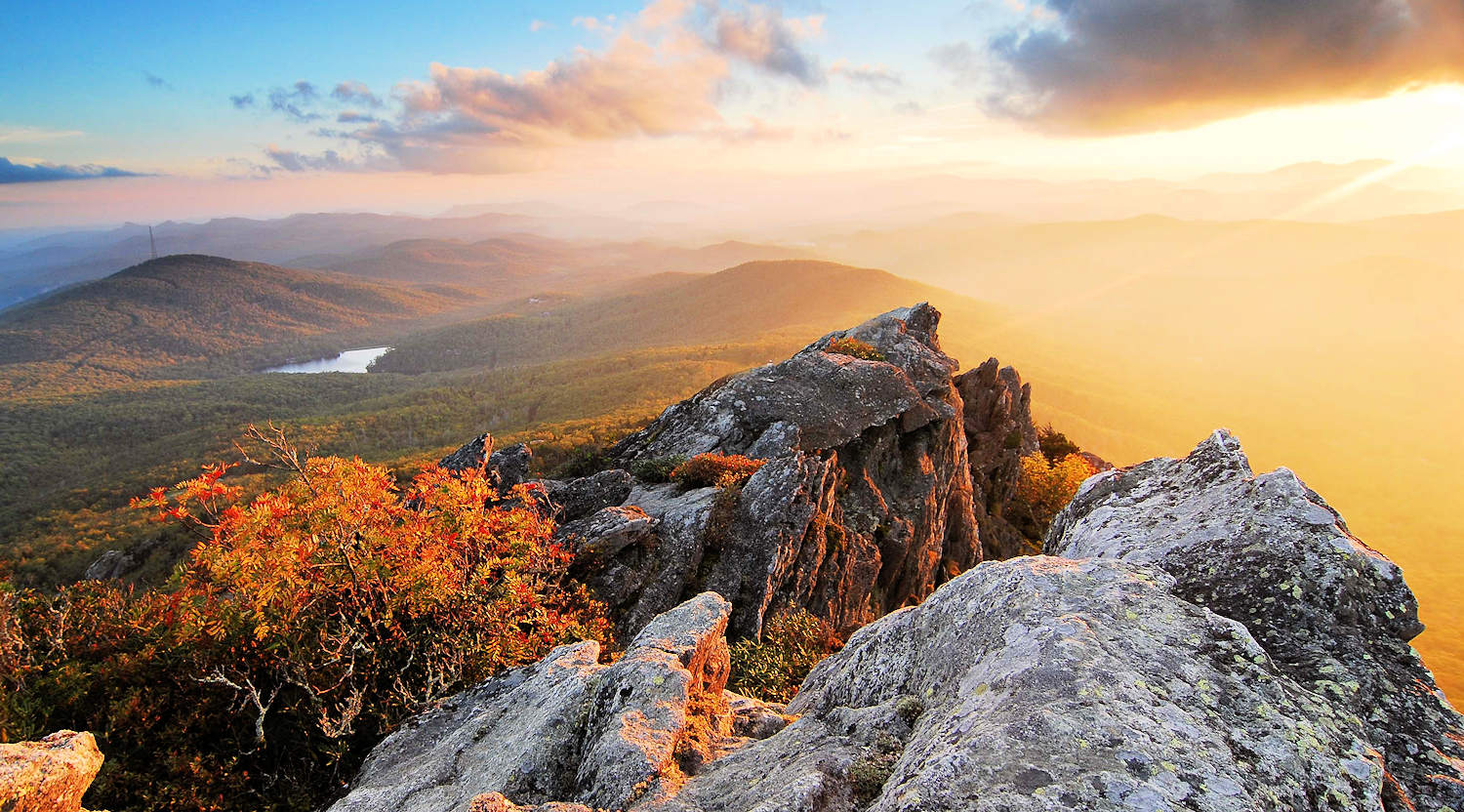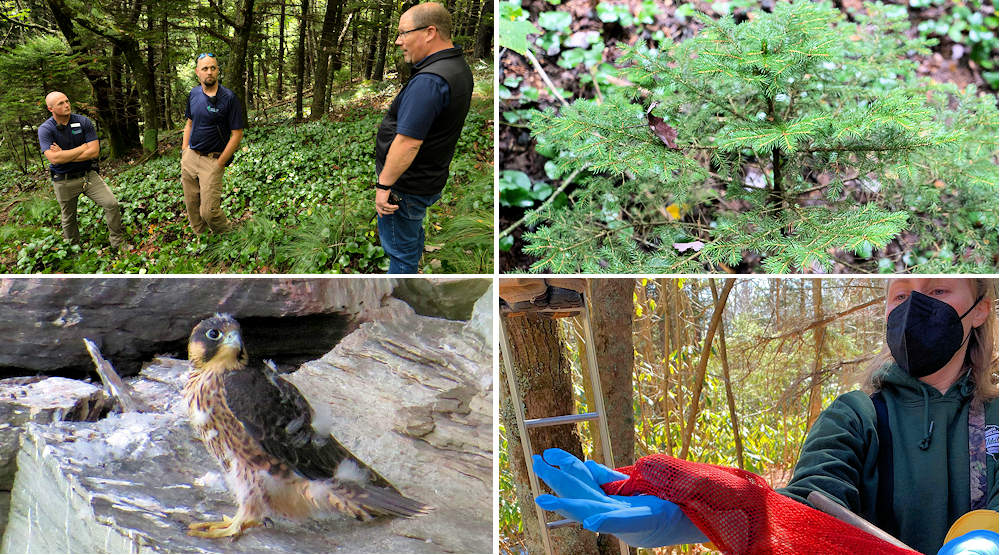
Conservation
Grandfather Mountain, the not-for-profit nature park run by the Grandfather Mountain Stewardship Foundation, is brimming with wild wonder and natural beauty, home to 16 distinct ecological communities and 73 rare or endangered species. Formed hundreds of millions of years ago, the ancient landscape has an ecosystem that remains in a delicate balance. Despite its untamed ruggedness – from the towering peaks to the extreme weather patterns – this special place needs protecting to ensure its well-being and success.
Park founder Hugh Morton truly laid the groundwork for taking care of the natural world here through his environmental advocacy. He was a leader in the fight to protect North Carolina from air pollution and acid rain and was instrumental in the passage of the state’s “Clean Smokestacks Act” in 2002. The aim of this legislation was to improve air quality and curb haze by imposing limits on the emission of certain pollutants at power plants. Morton also photographed and produced “The Search for Clean Air,” narrated by Walter Cronkite and aired nationally on PBS in 1995, to develop grassroots support for clean air.
He, likewise, led the charge for Grandfather being designated by the United Nations Educational, Scientific and Cultural Organization (UNESCO) as an International Biosphere Reserve in 1992. Today, there is a renewed focus on carrying his legacy as a passionate steward of this mountain forward.
There’s certainly more than meets the eye when it comes to the work to do just that. The natural resource management team’s behind-the-scenes efforts to protect Grandfather’s native species, both threatened and common, and defend against invasive ones requires lots of planning, a big-picture mindset and, of course, field hours – more than 1,000 this year.
After all, the mountain is a unique microclimate (its soil types, moisture levels and weather all differ from the surrounding areas, with a regular temperature difference of 10 to 15 degrees), and the air, soil, flora and fauna here are all interconnected. There is much to look after, and every piece has its purpose.
“We do what we do because we are passionate and have a genuine care for Grandfather Mountain,” said H Patton III, natural resource management specialist for the Grandfather Mountain Stewardship Foundation. “We work hard because we see the value in conservation and preservation, and the best way to share that passion is by putting in the time. Every comment about how great our trails are or how beautiful this mountain is just fuels us to work harder to maintain that.”
With much of the plant and animal life on the mountain at risk of extinction, the more hands the better. Along with partners at Grandfather Mountain State Park, the North Carolina Wildlife Resources Commission (NCWRC) and many other conservation agencies and organizations, Grandfather’s natural resource management team keeps a close eye on endangered species, doing frequent monitoring to gather data and teaching visitors about how they can do their part in conservation efforts both on Grandfather Mountain and at home.
Patton and his team juggle a slate of nearly 15 seasonal and recurring projects – with a focus ranging from plants and trees, to birds, to small mammals, to citizen-science opportunities – to make sure the mountain’s biodiversity continues to thrive. This is in addition to the hundreds of hours put into trail maintenance in the park – including replacing cables and ladders, adding rock steps to sections of trail and more – as well as significant time roving those trails and interacting with guests.
Among the project lineup is work with the NCWRC putting up boxes for the nesting or temporary housing of the Carolina northern flying squirrel and the northern saw-whet owl, considered critical to the Southern Appalachian spruce-fir forest blanketing Grandfather Mountain.
The flying squirrels are deemed “indicator species,” meaning their health points to the health of the whole ecosystem. Since truffles – a fungus that thrives at the foot of red spruce and Fraser fir trees – are their main source of food, the rising temperatures negatively impacting those trees (the gliding mammals’ preferred habitat) and causing hardwoods to take over are of great concern. If these nocturnal creatures are on the brink, the rest of the ecosystem could be, too.

In addition to surveying flying squirrels, the team is also conducting research on salamanders on the mountain and will be joining the Salamander Population and Adaptation Research Collaboration Network (SPARCNet), with a focus on red-backed salamanders’ climate adaptations and population dynamics.
“Grandfather Mountain will be the southernmost site in the entirety of the project,” Patton said. “The project aims to integrate this hands-on research into educational opportunities for K-12 groups, as well as undergraduate students.”
Then there’s the ongoing undertaking to treat hemlocks in attempts to create more resiliency in the trees and help further the healthy population throughout the park that has been taking place since 2004. In 2022, 89 new hemlock trees were successfully treated, with plans to tackle additional ones deeper in the forest. Although hemlock woolly adelgid (the pest that is affecting hemlock trees) is still present on the mountain, this decades-long program to manage the health of the trees has been successful, with minimal die-off of Grandfather’s hemlocks.
As for the team’s “defensive strategy,” much manual labor goes into minimizing the presence of encroaching threats that like to wreak havoc, such as coltsfoot, garlic mustard, crown vetch, spotted knapweed and Oriental bittersweet. The removal of these species is a near-constant battle, often requiring the demanding task of hand-pulling them.
Due to the sensitive flora and fauna on Grandfather Mountain, herbicide sprays are not typically used to combat the invasive plants, which is why the natural resource technicians do their best to stay vigilant. Utilizing the “early detection, rapid response” method when dealing with invasive species, the natural resource management team is able to prevent these species from establishing themselves on the landscape.
“Garlic mustard seeds can stay stored in the soil for up to five years,” Patton said. “This means that if we miss a year of removal, we have set ourselves back five years immediately.”
Not only does every piece in this ecosystem have its purpose – so, too, does every task. It’s all of the tireless conservation work, from the day-to-day duties to the special projects, that helps preserve this beloved mountain for future generations to learn about and love.
“The work that the natural resource department performs is invaluable,” Patton said. “I am very grateful to be able to play such a key role in maintaining such a unique place.”
“Grandfather Mountain’s mission statement is about cultivating conservation in our visitors by using the wonders here to create inspiration,” he added. “Without this department, there wouldn’t be trail systems to explore. Without the opportunity to explore, there is a gap in understanding. When there is a gap in understanding, it is hard to develop the true value. This department directly preserves the wonders found here and helps us to complete our mission. That is where the importance lies.”
Read more about Grandfather Mountain’s Unique Ecology, Sustainability at Grandfather, and our Education Programs.
